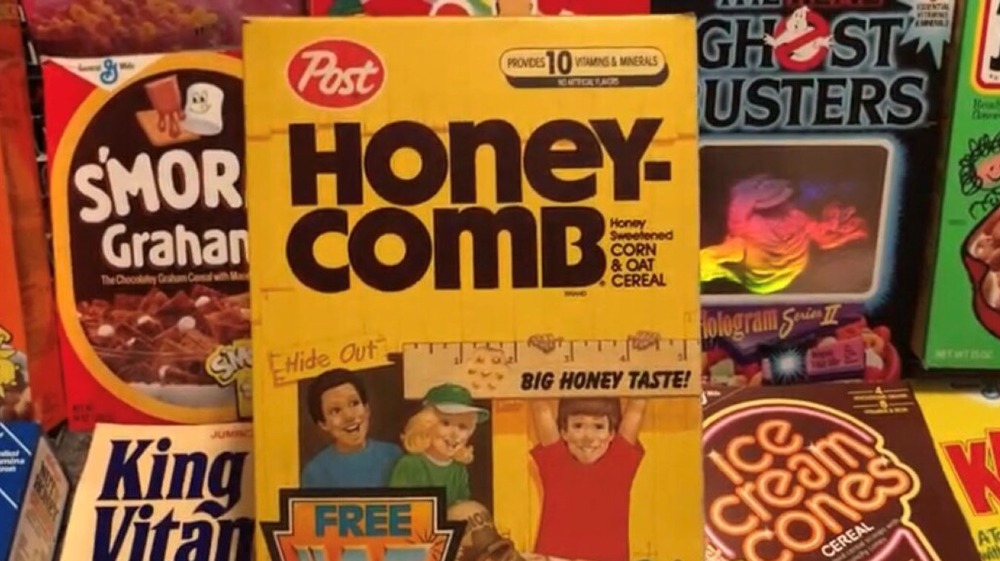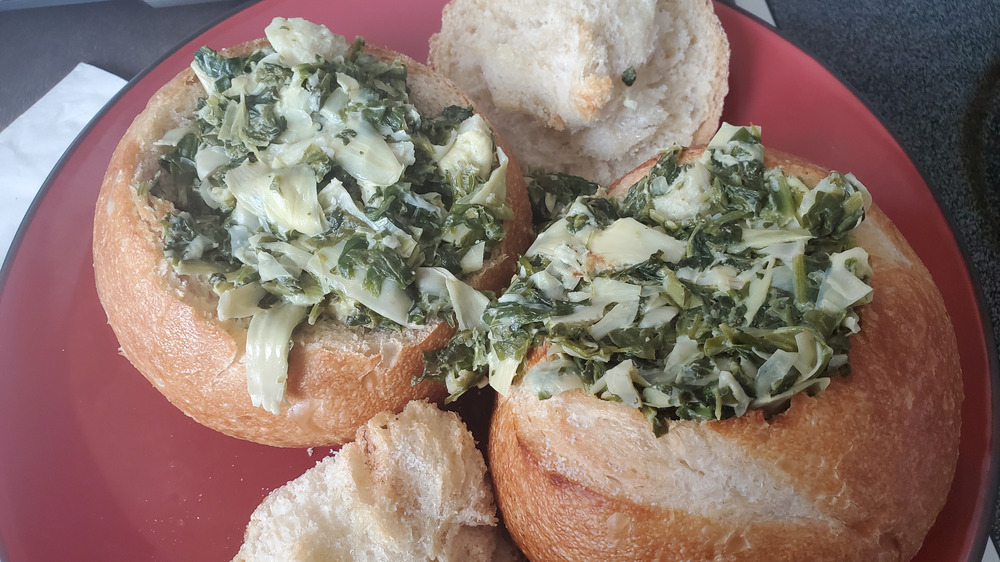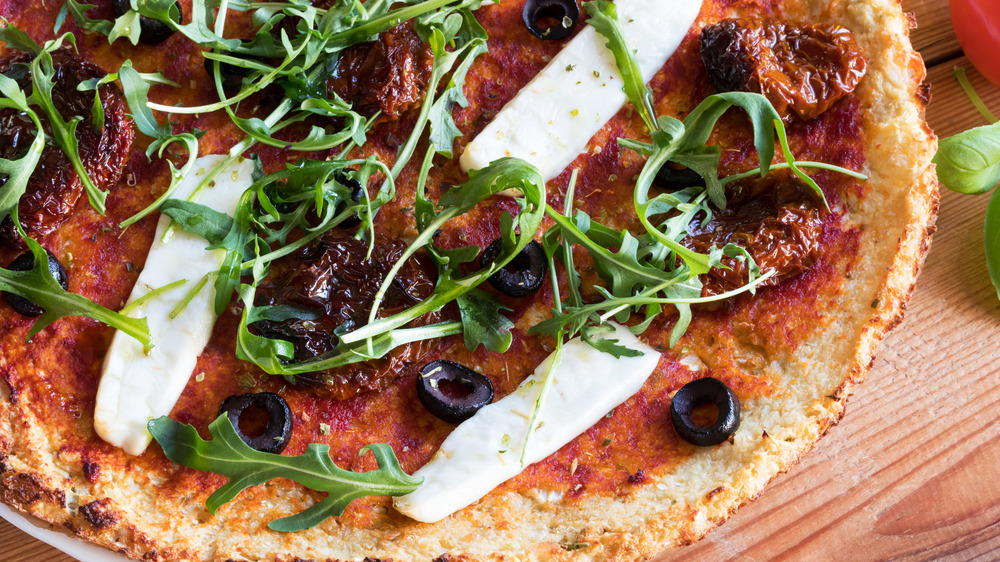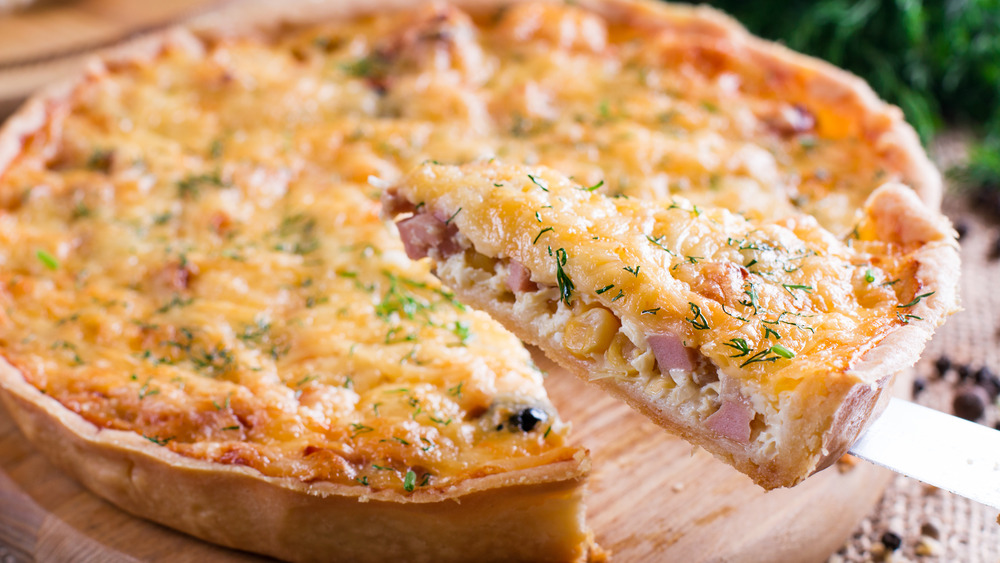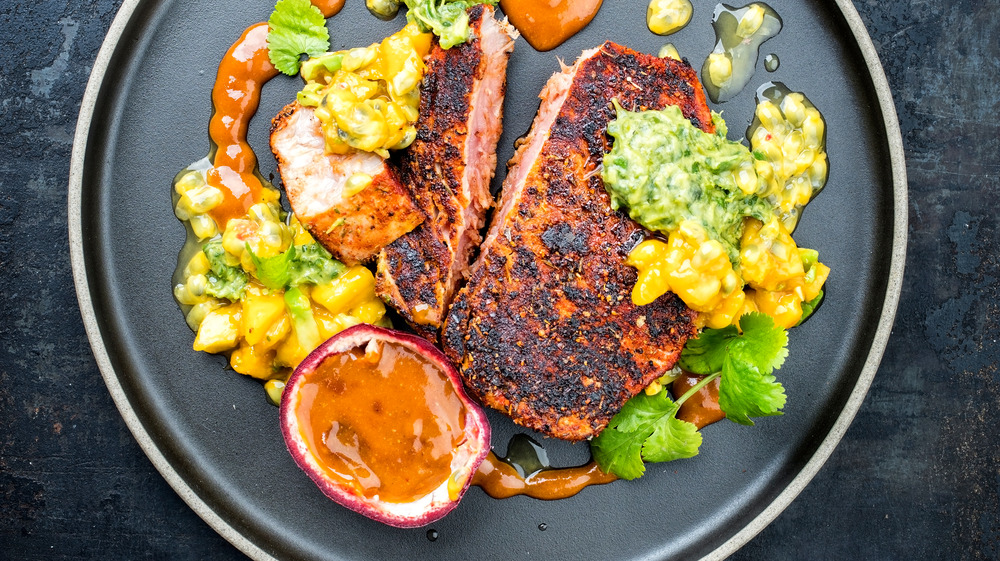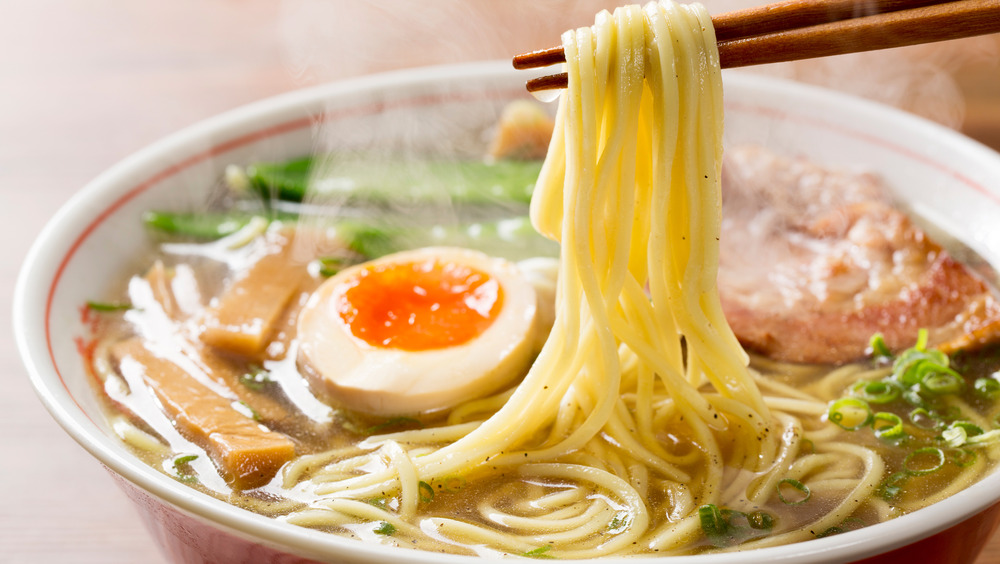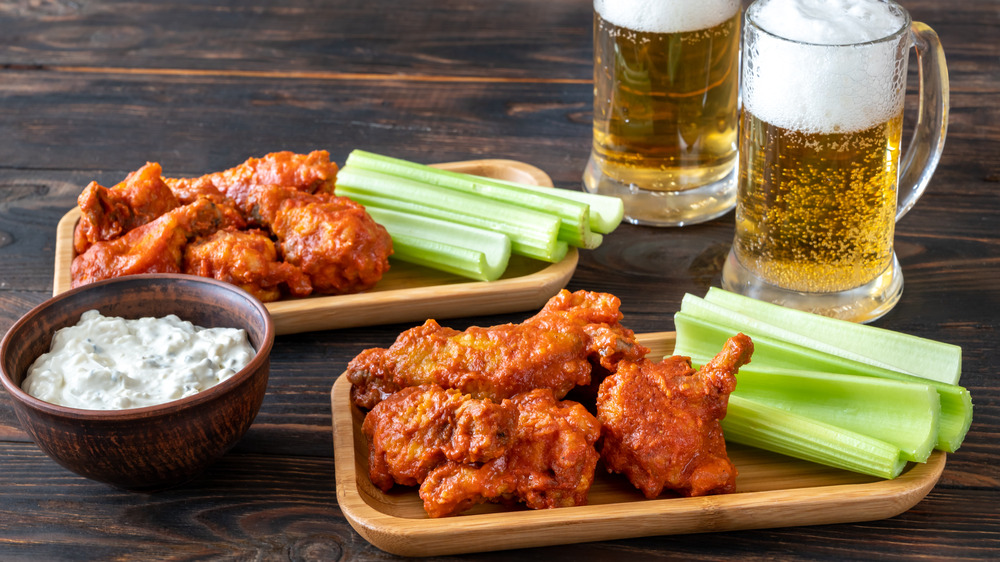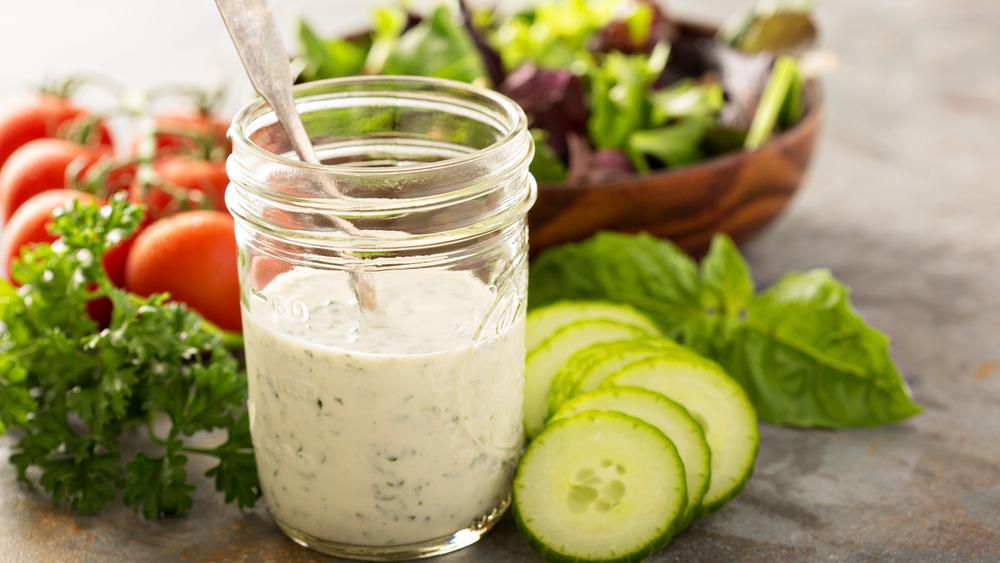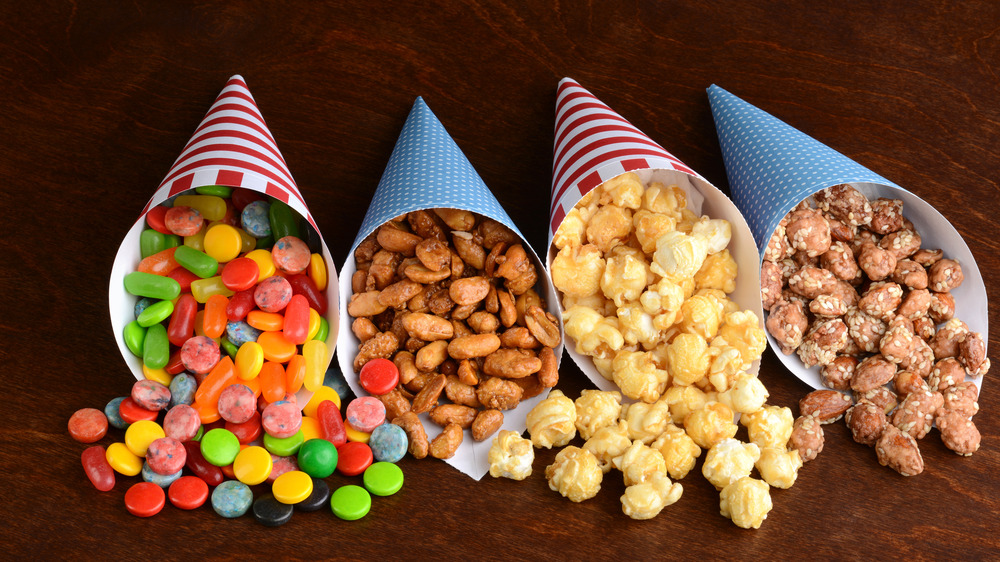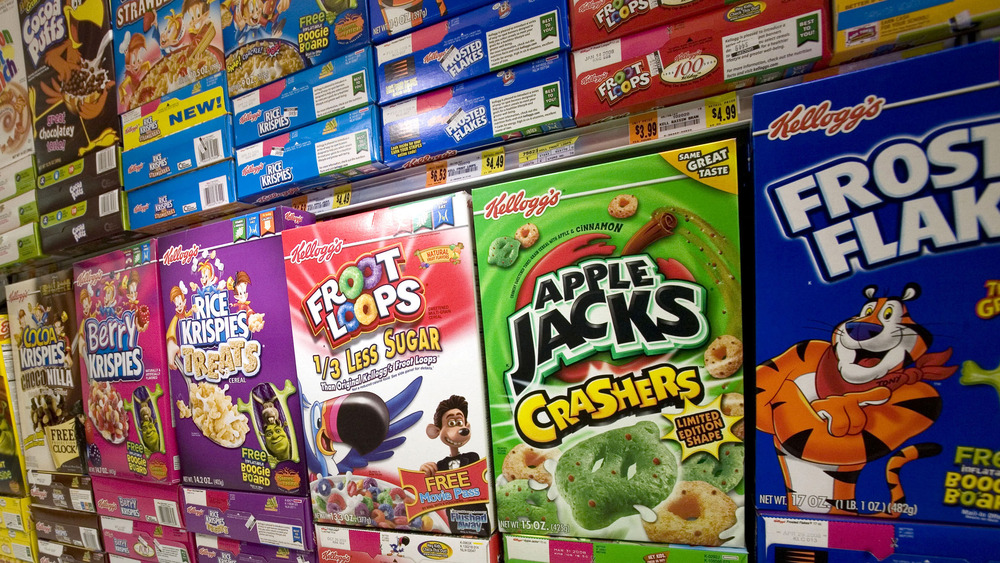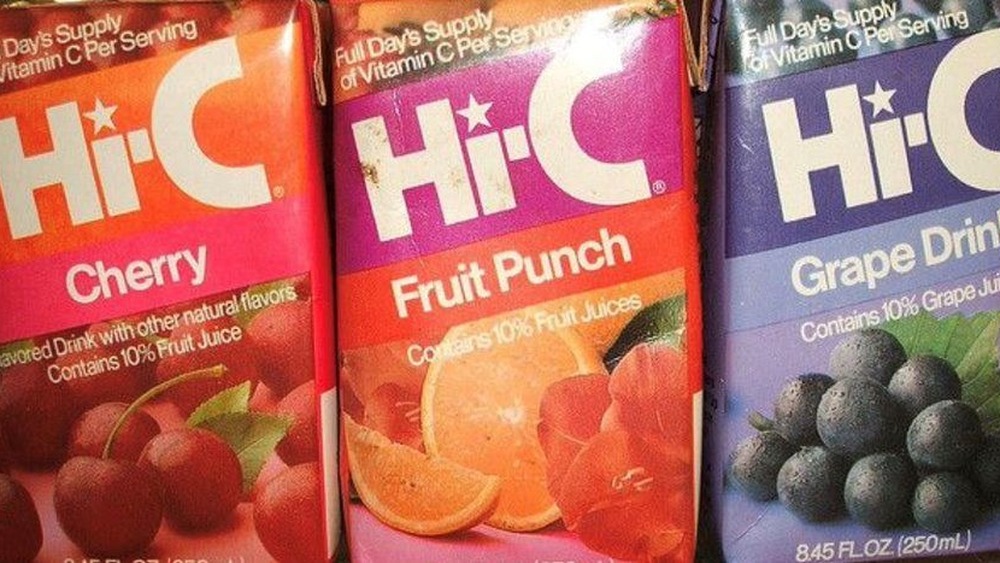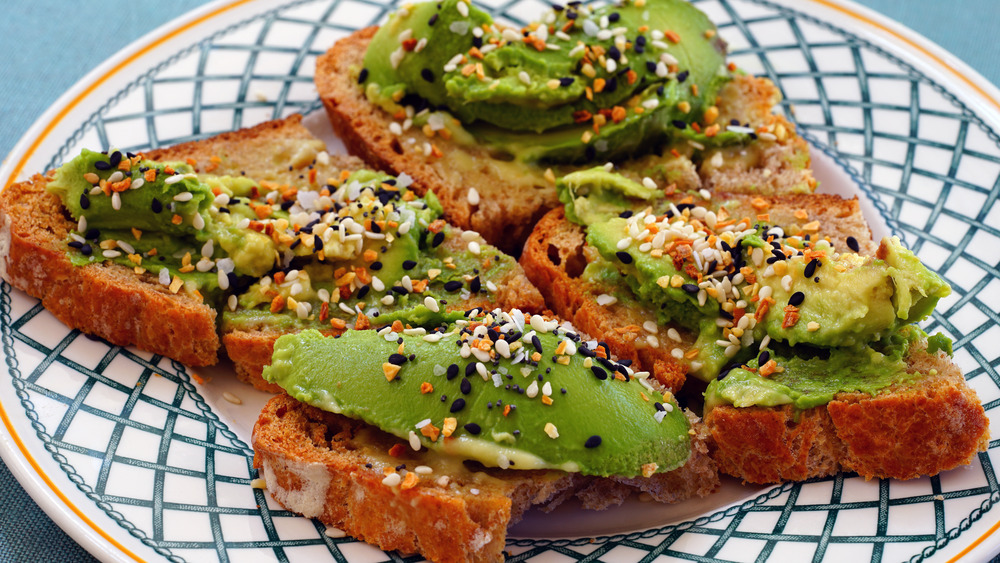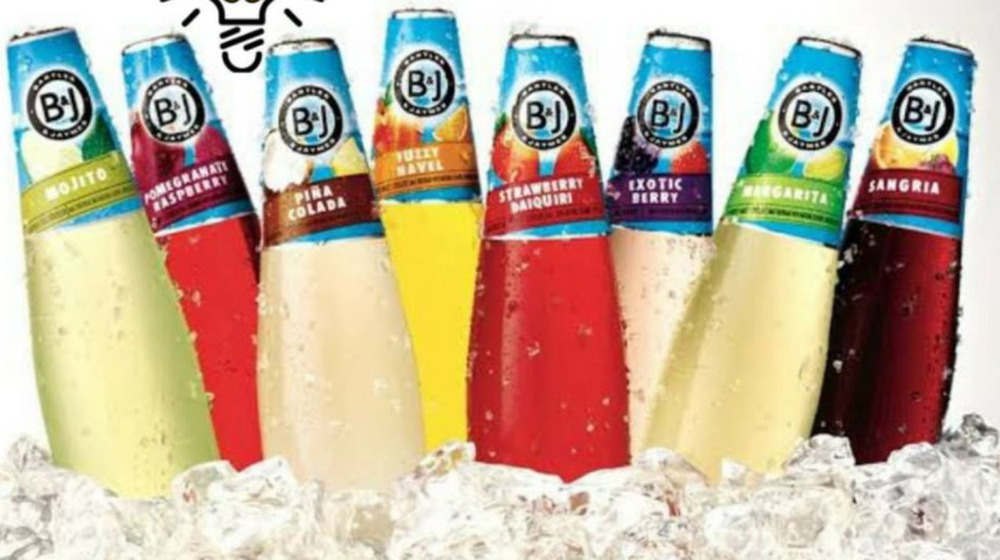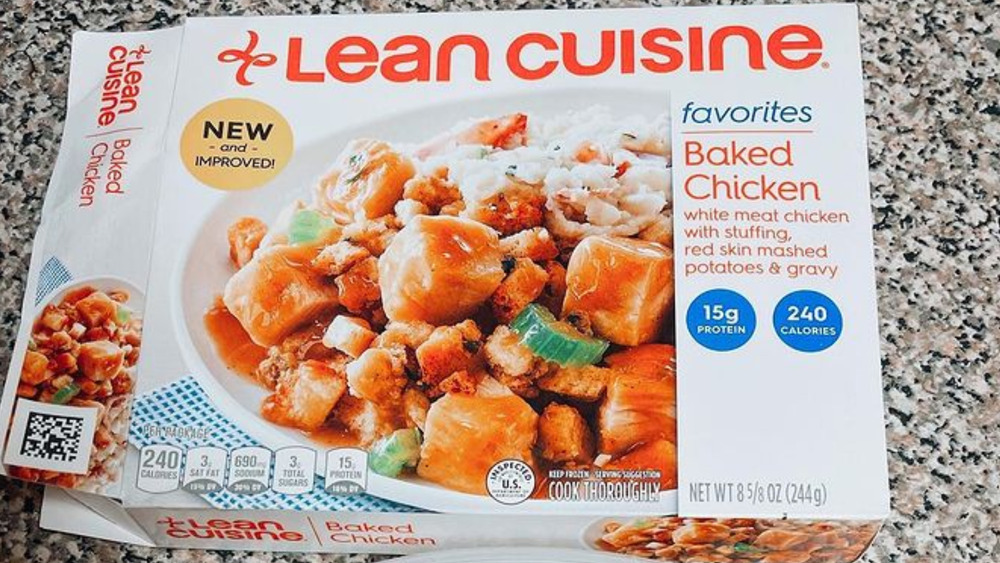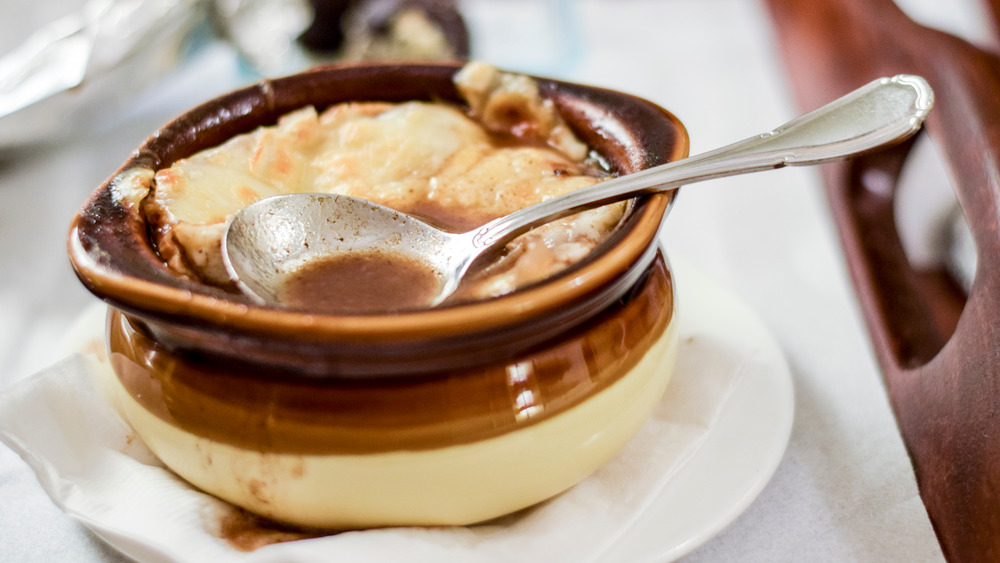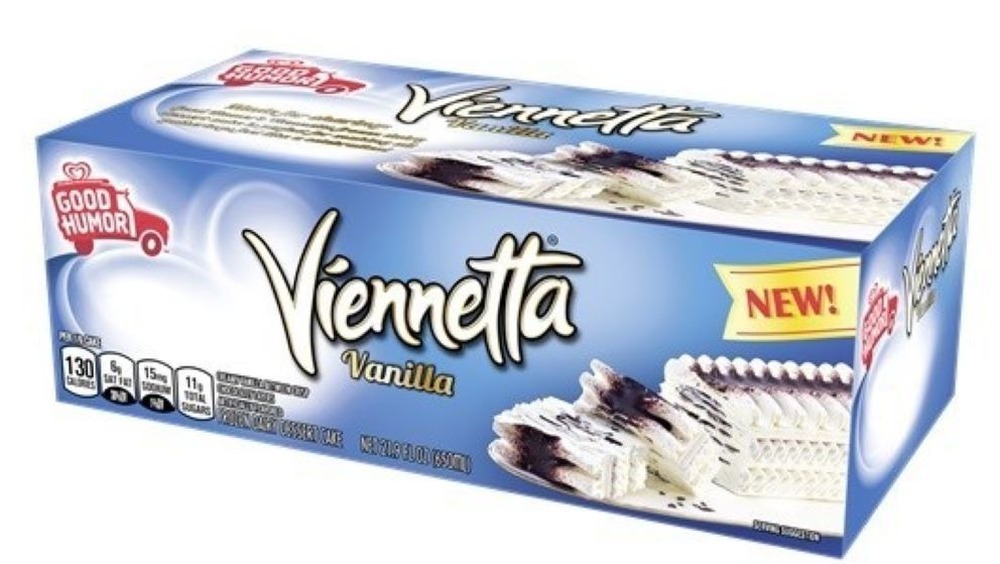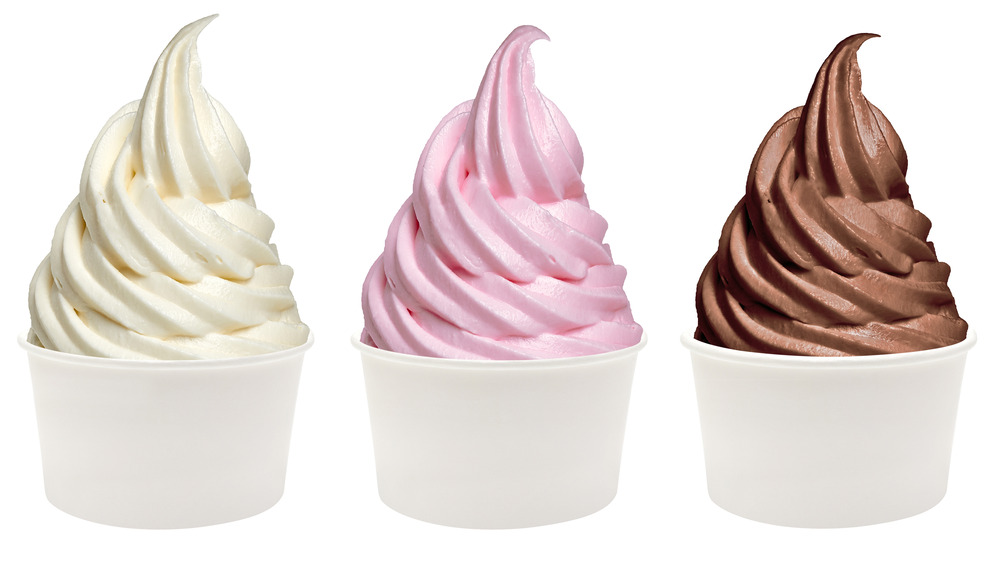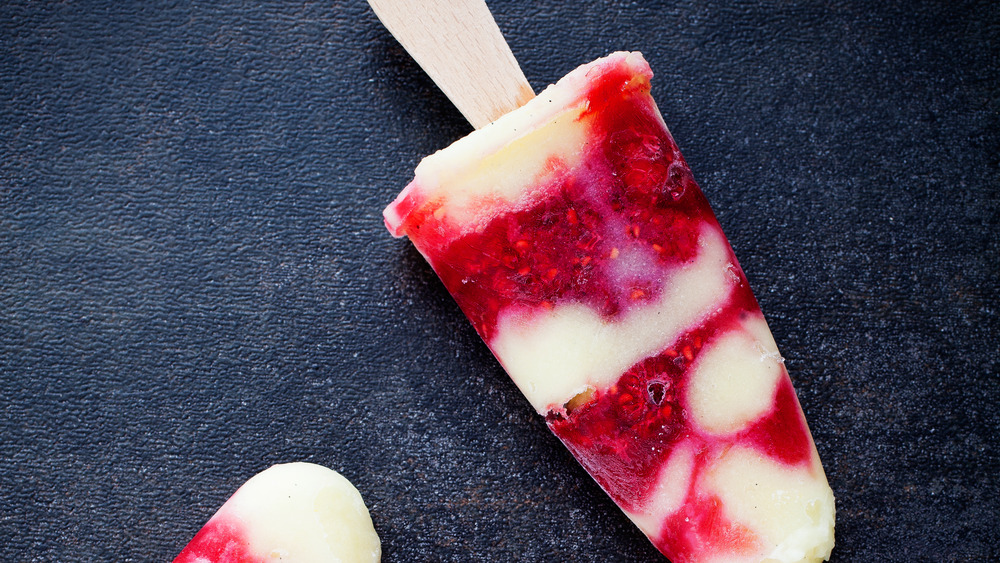Foods From The 1980s That Are Weirdly Making A Comeback
We may receive a commission on purchases made from links.
The year 2021 came saddled with some pretty big expectations. Unfortunately, given that COVID-19 risk didn't quite subside, few of those expectations were realized. That being said, the first few months of 2021 gave us reason to hope that the world could start turning again, and dramatically at that. That is, after all, how things went in the past.
Think, for example, of how the war and pandemic-ravaged nineteen-teens gave way to the Roaring Twenties, with all of its frivolity and indulgence (via Art Deco Style). And after the economically-challenged 1970s, the 1980s brought with it luxury and opulence — so that right before our very eyes, leisure suits gave way to power suits, long hair gave way to the slicked back Wall Street look, and alfalfa sprouts gave way to caviar and foie gras (via Town and Country).
Those fluctuations should provide further hope for those of us who lived through tough pandemic times in 2020. In 2021, with vaccinations on the rise, it even could be possible to sense a 1980s vibe in the air — or perhaps that's just the aroma of chicken wings, French onion soup, and everything bagel seasoning making their comeback. In fact, all these 1980s foods have been making a comeback. So, is it really that weird to think that a return to shoulder pads, smooth jazz, and high-concept cinema might not be too far behind?
Bread Bowls: An '80s trend from the Middle Ages that's back again
When bread bowls started turning up as dinnerware and partyware in the 1980s, they weren't exactly new. Fact was, bread bowls have been around since at least as far back as the Middle Ages (via Bon Appetit), when repurposing a stale loaf of bread by hollowing it out and filling it up with hot stew, soup, or porridge became a way to cope amid famine conditions (via Medieval Life). Accordingly, the advent of bread bowls in the 1980s represented a "renaissance" of sorts, albeit an ironic one given that bread bowls made their 1980s-return as a way of giving soup merchants an excuse to charge more for their wares, according to Fast Company.
Today, bread bowls appear to be riding the wave of a comeback once again. And once again, the comeback may represent the very antithesis of the purpose that bread bowls were originally meant to serve. You see, this comeback appears to have been engineered single-handedly by bakery-café fast casual restaurant giant, Panera Bread. "Only a few months back," wrote Fischer & Weiser's Culinary Adventure blog in 2019, "a national bread-centric chain called Panera introduced a 'hot new trend'" that was "soup served in a bowl of hollowed-out bread. And, well, if Panera Bread says it's a hot new trend, then who is to argue?
Sun-dried tomatoes: Back from the '80s, thanks to umami
During the 1980s, sun-dried tomatoes were "ubiquitous" in American cuisine (via Taste). What made sun-dried tomatoes so popular, according to David Kamp, author of The United States of Arugula, is that they were "versatile and simple" and not "too outlandish" (via Taste). "You could toss them in anything," Kamp elaborated. In fact, people did, tossing them into pastas and salads and onto pizzas, filling them with goat cheese, and even mincing and kneading them into bread dough and baking them up as sun-dried tomato bagels and dinner rolls.
By the mid-1990s, however, it appeared that sun-dried tomatoes' day in the sun was drawing to a close (via Taste). When food critic Ruth Reichl accused the savory dried fruit of being "monotonous," that seemed to be the last straw. Or was it? Apparently rumors of the demise of sun-dried tomatoes have been greatly exaggerated because it appears that they are back – and it may be that we have the umami trend to thank for that. As the LA Times wrote in 2019, "sun-dried tomatoes embody the sweetness of the fruit but with a condensed and intensified flavor that develops through the drying process until they become umami lozenges — the perfect pantry staple."
Quiche: It's too versatile to be stuck in the 1980s
Quiche, which became popular in 1970s, was still enjoying its heyday in the early 1980s, when "it was served in countless restaurants on stoneware plates with melon wedges, grapes and some kind of green shrub." That's what the The New York Times wrote in 1987 — in an apparent attempt to help stage a comeback for the dairy-rich meal-in-a-pastry. That comeback had become necessary thanks to the publication of Bruce Fierstein's Real Men Don't Eat Quiche. Published in 1982, the bestseller poked fun at quiche for being "effeminate." So influential was Fierstein's book that "quiche sales dropped precipitously as men everywhere immediately stopped eating the tasty pastry," according to the Columbus Dispatch.
Now, however, quiche is making a comeback, and it's high time too because, as the Dispatch further noted, quiche "is unbeatable for breakfast, luscious for lunch, and superb for a light supper. Best of all, you can make one with almost any filling you want." That was in 2018, and quiche has only been gaining ground since then. In 2020, The Dallas Morning News observed that quiche is "emerging" once again because "quiche is all things to all meals, the answer to what is for breakfast, lunch, brunch, or dinner. Add fruit for breakfast or brunch, or salad for lunch or dinner, and meals are complete."
Take it from us, this quiche is exactly what your life needs.
Blackened foods: A 1980s trend that's reemerged in a big way
The late great chef, Paul Prudhomme has been credited with introducing the world to blackened redfish. Prudhomme's innovation, which "combined the richness of a well-buttered thin redfish fillet with a...spice mixture," single-handedly brought Cajun food to prominence in the 1980s, according to Cooking Light.
In fact, the Cajun trend became so hot in the 1980s that when Prudhomme opened a pop-up version of his legendary New Orleans restaurant, K Paul's, on New York City's Upper West Side in 1985, it drew a crowd of 250 people — even after the New York City health department shut the place down temporarily over hygiene concerns (via The New York Times). In the years that followed, redfish became so popular that it became overfished – to the point where it is no longer legal to fish for it in most of the U.S. (via Food52).
But who needs redfish, when you can enhance just about any animal protein by coating it with butter and blackening spices and allowing it to char — especially when those blackening spices are now readily available, pre-mixed, at virtually any supermarket? In 2018, Food52 proclaimed that with or without redfish, blackening was ready for its comeback, and it was true. "Blackened" has even lent its name to the 80's band Metallica's own brand of high-end whiskey, which launched in 2018 and is still earning raves.
Ramen noodles: An '80s trend that's more popular than ever
Nissin initiated an "American ramen trend" in 1970, when its "Top Ramen first appeared on store shelves," according to restaurant industry insider, Food Dive. Ramen rose to trendy in the 1980s because it was "wickedly cheap" and "edible raw," according to the Village Voice, which also noted that ramen was just right for the Cold War, which was then in full swing, because "in a nuclear winter, it would be the cockroaches and the ramen that survived."
As far as college kids go, ramen noodles never really fell from favor. Instant ramen remains their go-to meal and late-night snack it has always been. However, in recent years, ramen has also taken on a more sophisticated, worldly vibe that has nothing to do with instant noodles, Styrofoam cups, or college kids, for that matter. And that is its own kind of comeback.
As of 2021, you can find restaurants dedicated to ramen in major cities everywhere (via USA Today). In 2019 alone, "106.4 billion servings of ramen were eaten worldwide — working out to 290 million per day," according to the World Instant Noodle Foundation, via Food Dive. Today, the U.S. is the sixth-biggest consumer of ramen, and the biggest outside of Asia. And yes, in case you were wondering, you are duty-bound to slurp your ramen loudly, according to Smithsonian Magazine.
Buffalo chicken wings: Popular since the 1980s but soaring since 2020
Buffalo chicken wings rose to prominence in the 1980s, when health-conscious consumers started favoring "boneless-skinless breast meat." This left chicken suppliers with a chicken wing surplus (via National Chicken Council). Hoping to rid themselves of that surplus, chicken suppliers took to selling wings on the cheap. Restaurants and bars saw this as an opportunity to purchase inexpensive protein, spice it, fry it, and sell it for cheap — even with a reasonable markup.
As an extra-added bonus, spicy chicken wings tend to make people thirsty, which translates loosely into "more beer gets sold." On top of that, all of this was happening as sports bars started popping up across America. Chicken wings were already well-entrenched in American culture (via Smithsonian Magazine), but the pandemic has raised the profile of both chicken and chicken wings considerably.
According to Meat & Poultry, "fifty percent of chicken-eating consumers in the United States have eaten [chicken] more than other protein in the past nine months." In part, that may be due to the fact that chicken wings are one of the easiest foods to order and enjoy via takeout at a time when takeout has been one of the only options for accessing fast food (via Eat This, Not That!). And this is despite the fact that at one point during the pandemic, chicken wings were associated with a nasty rumor that one could catch COVID-19 from frozen food packaging (via Fortune).
Ranch dressing: A 1980s trend that's become an all-American classic
Steve Henson was a plumber from Nebraska working on a construction crew in Alaska when he came up with a mayonnaise-and-buttermilk-based salad dressing that made use of dried herbs and spices for seasoning, according to (via The New York Times). A few years later, in 1954, when Henson and his wife moved to California and opened a guest ranch, the Hidden Valley, they served the dressing, which became so popular that guests started requesting souvenir jars. In 1983, Hidden Valley Ranch Salad Dressing was introduced in supermarkets, and an obsession spread across America — peaking in 1986 with the introduction of Cool Ranch Doritos.
For a good, long time after that, ranch dressing remained a part of Americana, but it was widely reviled by foodies who maintained that it "didn't deserve a place in a serious restaurant kitchen," according to Bon Appetit in 2015, even while pointing out that a comeback appeared to be afoot.
At first, that comeback might have been characterized as mildly transgressive, with people buying into ranch dressing primarily because it represented a "guilty pleasure." Before too long, however, ranch dressing and ranch seasoning started appearing in places that would never have tolerated it in the past — in upscale kitchens, drizzled on pizza, marinating lamb, and acting as the "new" — and possibly better — dipping sauce for chicken wings (via Mandatory). With the pandemic having fueled a national wing obsession (via Restaurant Business), ranch dressing is now truly having a moment.
Flavored popcorn: Started in the 1980s and getting even wilder today
You know those tins of flavored popcorn that people send as gifts around the holidays? Well, you can thank the 1980s for that. "A scant two years ago, the The New York Times wrote in 1983, "there was plain popcorn and buttered popcorn and caramel popcorn, and a few slightly more exotic flavors such as cinnamon for those who would dare," but now, there is "pizza-flavored popcorn, watermelon-flavored popcorn and taco-flavored popcorn, and the stores that sell them are called gourmet shops in the industry."
The New York Times also pointed out at the time that "about 70 percent of the country's popcorn is eaten at home, generating about $200 million in sales during 1982," with "popcorn confections and other specialty items accounting for another $100 million." Again, that was in 1983, but looking back, it could seem as if the New York Times was penning a future-letter to "Pandemic America," one which predicted the resurgence of home-popped popcorn and popcorn confections at a time when much of America found themselves stuck at home.
The latest varieties of flavored popcorn are wilder than ever, including such flavors as fried-chicken (via Boston Herald), marmite, pumpkin spice, lemon sherbet, caffeine-infused, and gin and tonic, according to Little White Lies, and dark chocolate pretzel, cookies 'n cream, and bacon and cheddar (via Uptown Popcorn).
Sugary cereal: An 80s trend that's returning despite health concerns
Sugary breakfast cereals have been around since 1939, according to Mr. Breakfast. Ironically, Jim Rex, the inventor of the first sugary cereal — appropriately named Ranger Joe Wheat Honnies — came up with the idea because he was horrified by how much sugar he saw his kids dumping into their bowls of non-sugar-cereal. Post's Sugar Crisp came next, according to Women's Health: "Released in 1948...it was first in a looong line of sugar-laden cereals that would soon become the norm." By the 1980s, "co-branding cereal was the game," with sugar cereals partnering with kiddie entertainment, thereby locking down the interest of American children (via The New York Times).
By the 1990s, however, consumers were becoming increasingly health-conscious, and sugar cereals came to shoulder at least some of the blame for the increase in obesity among American children (via Omaha World Herald). Defensively, many sugar cereals began dropping the word "sugar" from their names.
Now it appears that cereal manufacturers have once again been "doubling down on their sugary ways," according to The Wall Street Journal (via CBS News). The reason? Dwindling sales. As much as American consumers don't "want" sugary breakfast cereal, they also don't seem to have any interest in buying breakfast cereal that doesn't come pre-sweetened. Accordingly, cereal manufacturers have been steadily "increasing the sugar content of some cereals after healthier versions failed to win back consumers who were defecting to Greek-style yogurt, protein bars, and other breakfast items with higher protein and fewer carbohydrates."
Hi-C: An '80s juice that's poised to be big again
Given the resurgence in popularity of sugar-laden cereals, it shouldn't be all that surprising to learn that sugar-sweetened fruit "drinks" are coming back into style. Did you notice we didn't say "juice"? That's because the beloved fruit "drinks" that had their heyday in the 1980s (via The Daily Meal) tended to contain very little actual juice. Hi-C, for one, contained a mere 10 percent juice — and this remained the case in the 2010s, USA Today reported. What these fruit drinks did contain was a lot of sugar, often in the form of high fructose corn syrup.
Hi-C, which had been around since 1946, enjoyed a huge surge of popularity in the 1980s thanks, in part, to the introduction of their Ecto Cooler juice boxes. Hi-C became a mainstay at McDonald's, with the Orange Lava Burst flavor becoming a cult favorite. So then why did McDonald's discontinue it in 2017?
Strangely enough, the decision had less to do with sugar and more to do with licensing obligations, according to Today, which explained in 2017 that McDonald's had recently entered into a partnership with Coca-Cola, makers of Sprite TropicBerry. "Apparently, Hi-C would have stolen the new drink's thunder."
Now, fans of Hi-C Orange Lava Burst can breathe a sigh of relief. On February 21, 2021, McDonald's announced it was bringing the popular drink back, and it should be available nationwide by summer (via PR Newswire).
Everything bagel seasoning: It's too tasty to leave behind in the 1980s
"Poppy seeds, sesame seeds, dried minced garlic and onion, and sea salt. These five ingredients aren't necessarily the heroes of the spice world, but mixed together, they revolutionized the bagel world," as Atlas Obscura puts it. Although it will probably never be known who exactly was the first person to throw these five ingredients together on top of a bagel, there are a few contenders, including Tom Bastianich.
What is known for certain is that by the 1980s, those five ingredients together were huge...at least as bagel seasoning. In fact, for quite a long time after that, those five ingredients came together for one purpose and one purpose only: to make a bagel taste like...everything.
Fast forwarding to now, however, it turns out that there's a whole new use for everything bagel seasoning. And that is as a seasoning...not just for bagels but for everything. In fact, Trader Joe's sells a version under the name, "Everything But The Bagel Seasoning." And who among us isn't wondering why we never of thought of it before?
'80s-style wine coolers: Back at the party in 2020
"Remember the wine cooler?" wrote Forbes in 2019. "It's back." Technically, it's true, as in iconic wine-cooler maker, Bartles & Jaymes, has come out with a pre-packaged (canned) cocktail that is both fizzy and made with wine. However, what is in those cans along with the fizzy wine is not what people who came of wine-drinking age during the wine-cooler-80s think of as "wine coolers."
The wine coolers of the 1980s were made from wine, carbonated water, and sugar, which made them as close as you could get to a commercially bottled wine-spritzer (i.e., wine diluted with soda). Not that anyone really needed a pre-bottled wine-spritzer when all you need to make your own wine spritzer at home is a glass of wine and a spritz. But 1980s wine coolers had their fans — such that wine coolers became big business, with Gallo, Seagrams, and Bartles & Jaymes as a few of the most popular players.
But then Congress had the bright idea of levying a massive excise tax on wine, thus making "wine blending bad business," according to Wine Folly. In response, cooler-manufacturers started replacing wine with cheap malt liquor. That's how Zima came to exist. On the plus side, taking wine out of the equation enabled beverage manufacturers to get super-creative with their flavors. On the negative side, is a wine cooler that waters down its wine with malt liquor — as Bartles & Jaymes does – really a wine cooler?
Lean Cuisine: An 80s health food trend that's replacing restaurants in 2020
Lean Cuisine's pre-prepared and calorie-conscious frozen meals debuted in the U.S. in 1981. Since then, the frozen food brand has been available in supermarkets across the country. However, it lost some considerable footing over the years, according to The Atlantic, which reported in 2014 that America's then-60-year-long love affair with frozen prepared meals was going through a bit of a rough patch. In fact, there was talk at the time of Nestlé unloading the brand altogether. Good thing they hung in there because frozen foods have been enjoying a huge comeback.
In April 2020, Food Processing reported that even before the pandemic, "the frozen foods department in grocery stores," had grown "$918 million" in the preceding 52 weeks, with sales totaling $54.6 billion (quoting National Frozen & Refrigerated Foods Association).
As the months have gone on with continuing "reduced access to restaurants and fast casual businesses due to the COVID-19 outbreak," demand has soared even further, according to Deepak Amin, CEO of Deep Indian Kitchen (via Food Processing). Apparently seeing a great opportunity, Nestlé grabbed it, relaunching more than half its existing offerings and introducing brand extension, Life Cuisine, "boasting gluten-free and high-protein attributes" (via Frozen Foods Biz).
French onion soup: A 1980s restaurant staple that might be back to stay
Americans started taking a keen interest in French cuisine starting in the 1970s (via Literary Hub). Some of the fancier French restaurants were serving nouvelle cuisine, with all its detailed precision, and on the more casual side of things were restaurants specializing in crepes and fondue. But by the mid-1980s, all these restaurants tended to have one item in common: French onion soup (via Saveur).
So ubiquitous was onion soup in those days that it came to be synonymous with steakhouses as well as French restaurants, according to Taste of Home. Although French cuisine in America, with its heavy sauces and hefty price tag, had to make room for the introduction and rise of other ethnic cuisines such as Japanese, Thai, pan-Asian, Northern Italian, and Indian, it appears that French onion soup is on the rise once again, at least at Panera Bread — especially at Panera Bread.
In a classic case of "you never realize what you want until its gone," it took Panera Bread's removing of French onion soup from its menu for its diehard fans to self-actualize as such. "The restaurant chain, known locally as St. Louis Bread Co., faced a flood of customer complaints after it removed [French onion soup]" from the menu in 2020, according to Ad Age (via KSDK). In response, Panera put French onion soup right back on the menu.
Vienetta ice cream: An '80s treat we can't wait to try again
Viennetta, a beloved mashup of ice-cream cake and ice-box cake, with wavy alternating layers of vanilla ice cream and chocolate candy, had its debut in the U.K. in 1982 and hit the U.S. soon after, according to Food & Wine. Although it has remained a beloved dessert in the U.K., it was discontinued in the U.S. in the 1990s. "'Fans have clamored for Viennetta's return for almost 30 years," according to a press release from Unilever, the parent company of ice cream brand Good Humor, dated January 5, 2021. "In 2021, Good Humor grants their wish."
Although it's unclear why Viennetta ever disappeared from American supermarkets frozen food aisles in the first place, it's easy to infer why Good Humor was eager to bring it back now. Over the course of the COVID-19 pandemic, frozen foods, which had been losing market share in recent years, have made a huge comeback, according to Deepak Amin, CEO of Deep Indian Kitchen (via Food Processing). And the winner among frozen food categories has been ice cream, according to the National Frozen & Refrigerated Foods Association, with sales representing $6.7 billion (of a total $54.6 billion for all frozen food categories).
Frozen yogurt: Trendy in the 1980s but a go-to since the 2000s
Although yogurt has been in the U.S. since the early 1900s, frozen yogurt wasn't even invented until the 1970s. According to 16 Handles, that first frozen yogurt was designed to be scooped the way you scoop hard ice cream –but it didn't really catch on. Then, in the 1980s, soft-serve frozen yogurt was invented.
Marketed as a soft serve dessert that tasted similar to ice cream, it took off in popularity as consumers began to pay attention to "healthy eating" and "healthy ingredients," according to the Frozen Yogurt Mix blog, which also noted that by 1990, frozen yogurt represented 10% of frozen dessert sales.
And therein lies the rub. Frozen yogurt was, ultimately, just another frozen dessert. As it turned out, no matter how "healthy" frozen yogurt might be, it's also pretty darn caloric, according to The Village Voice, which makes it not necessarily a better choice than ice cream. The disappointment was so palpable that Seinfeld mined it for the tragi-comedy of it all.
But guess what eventually has made a comeback? Frozen yogurt, only now it's not meant to taste like ice cream so much as like tangy yogurt, and now its marketing didn't necessarily promise low calories, low fat, or low anything, according to the The Seattle Times.
Pudding pops: Fans might bring back this bit of 1980s nostalgia
"During the 1980s, Jell-O Pudding Pops were featured freezer treats in millions of American homes," according to Culinary Lore. For totally "selfish" reasons (Jell-O wasn't making enough of a profit off of them), Jell-O Pudding Pops were unceremoniously dropped from the frozen food aisle dessert lineup in the 1990s. Fans took it hard — there were petitions back then, just not on the internet.
Caving slightly in 2004, Jell-O licensed the Pudding Pops name to Popsicle for a reboot. Now, you might think that Popsicle, being a brand that specializes in frozen desserts, would have done Pudding Pops proud. However, this was not how things played out, according to Culinary Lore. Instead, "the texture was different, and they were made in a Popsicle shape using existing popsicle molds, instead of in the traditional Pudding Pop shape." Thanks to unimpressive sales, Popsicle stopped making its version of Pudding Pops in 2011.
To this day, the world has still yet to meet an adequate replacement for the goodness that was real Jell-O Pudding Pops — when they were made by Jell-O. And so we can't say that Jell-O Pudding Pops, are back, per se. But that's not to say that people aren't trying. There's even an entire Reddit thread devoted to perfecting the art of making pudding pops at home. In other words, if Jell-O won't make them, then one of these days, and it could be soon, someone on the internet is going to figure out how.
